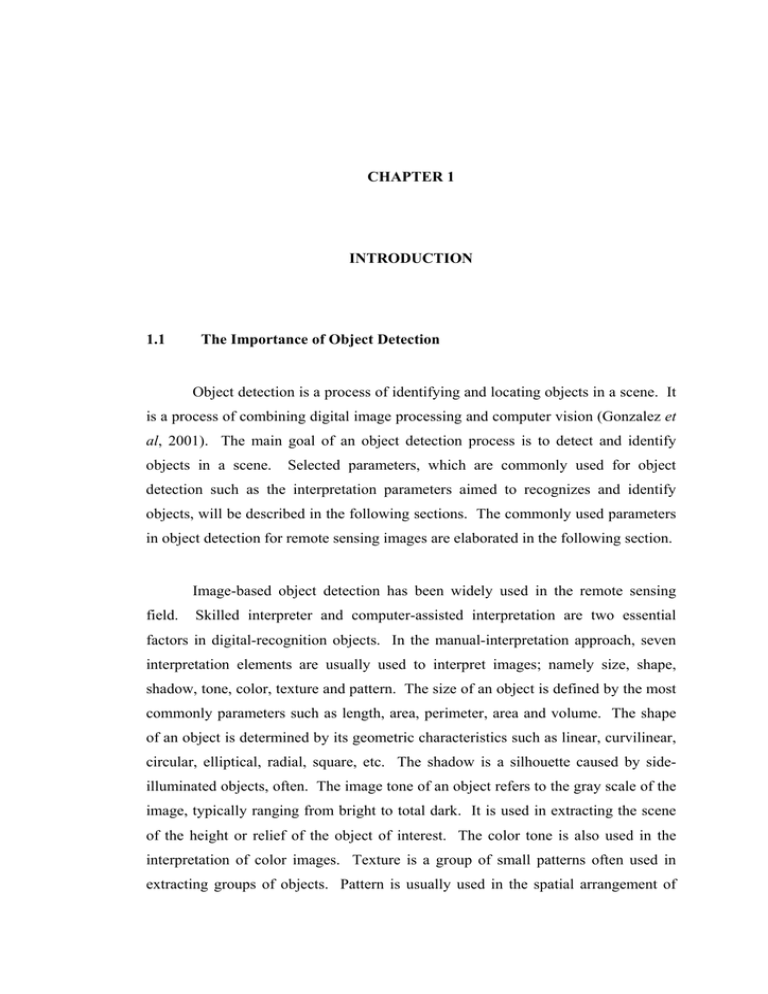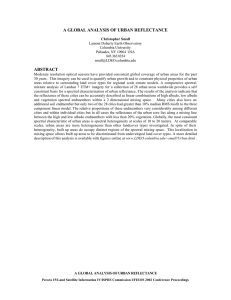Object detection is a process of identifying and locating objects... et object detection process is to detect and identify
advertisement

CHAPTER 1 INTRODUCTION 1.1 The Importance of Object Detection Object detection is a process of identifying and locating objects in a scene. It is a process of combining digital image processing and computer vision (Gonzalez et al, 2001). The main goal of an object detection process is to detect and identify objects in a scene. Selected parameters, which are commonly used for object detection such as the interpretation parameters aimed to recognizes and identify objects, will be described in the following sections. The commonly used parameters in object detection for remote sensing images are elaborated in the following section. Image-based object detection has been widely used in the remote sensing field. Skilled interpreter and computer-assisted interpretation are two essential factors in digital-recognition objects. In the manual-interpretation approach, seven interpretation elements are usually used to interpret images; namely size, shape, shadow, tone, color, texture and pattern. The size of an object is defined by the most commonly parameters such as length, area, perimeter, area and volume. The shape of an object is determined by its geometric characteristics such as linear, curvilinear, circular, elliptical, radial, square, etc. The shadow is a silhouette caused by sideilluminated objects, often. The image tone of an object refers to the gray scale of the image, typically ranging from bright to total dark. It is used in extracting the scene of the height or relief of the object of interest. The color tone is also used in the interpretation of color images. Texture is a group of small patterns often used in extracting groups of objects. Pattern is usually used in the spatial arrangement of 2 objects on the ground (systematic, unsystematic, etc.). Apart from the above seven interpretation elements, other elements are used in manual interpretation such as the associated relationships as the combination of the elements, geographic characteristics and configuration of the objects. A well-trained interpreter can interpret the image using the above elements easily as a dichotomous key (Jensen 2000). The use of digital interpretation approach is widely used in various applications. In this approach, the computer systems (including appropriate software) are used to extract object features using basic interpretation elements. The most common elements used for digital recognition are tone, color and texture. Tone and color of individuals in the scene are the two dominant interpretation elements used in the computer-based object detection based on statistical pattern recognition techniques (Hardin and Thomson, 1992). At present, both the manual and computerbased interpretation are used hand-in-hand, where each of these approaches compliment each other as fully computer-based interpretation is rather limited due to each of the dedicated systems being built for specific purposes. The image-based object detection has formed wide applications, which includes military and biomedical imaging. In military applications, recognizing and detecting of targets within specific areas has been the main focus. Such targets are crucial inputs into intelligence planning and monitoring. In the biomedical applications, object-detection has been carried out for assisting medical practitioners in diagnosis of diseases/sickness (Yuan-Hui Yu and Chin-Chen Chang, 2006). These include also recognition of fingerprints and eye pupil as biometric identification, apart from the study of human perception to vision and recognition ability. Image-based object detection and recognition is important, particularly for intelligence where it is widely used in the planning of military operations. It is also very important for assisting pilots, tanker operators, and shooters to detect and identify targets of interest. Using this technique the operator could identify the target of interest faster and more precisely. Computer-assisted object detection could be used for automatic detection of any object or target of interest. This is referred to as 3 automatic target recognition (ATR), which generally refers to the self-directed or aided target detection and recognition by computer processing of images from a variety of sensors such as forward looking infrared (FLIR), synthetic aperture radar (SAR), inverse synthetic aperture radar (ISAR), laser radar (LADAR), millimeter wave (MMW) radar, multispectral/ hyperspectral sensors, low-light television (LLTV), video, etc. ATR is an extremely important approach that is useful for targeting and surveillance missions of defense weapon systems operating from a variety of platforms (BHANU et al, 1997). Automatic target recognition aims to reduce the workload of human operators such as image analysts, pilots, and tankers, who are tasked with a large scope of activities ranging from assessing the battlefield/battlespace situation over large areas and volumes to targeting individual targets on land, sea, or air. It is also used to reacquire targets when used on unmanned lethal weapon systems such as missiles. The effectiveness and efficiency of locating and detecting targets is greatly increased with this application (Clark et al, 1997). In the context of medical imaging, object detection is widely used in detecting symptoms peculiar to disease or related to malfunction or strange organs. It uses the concept of detecting foreign bodies inside the human body. Yfantis et al. (2000) proposed an algorithm for detecting cancer using ultrasound image. The algorithm is based on calculating a number of attributes in the section of interest in the image and finding the distance in the multivariate space of the vector of attributes in the section from 2 predetermined centroids (cancerous and non-cancerous). If the distance from the non-cancerous centroid is smaller than the distance from the cancerous centroid the region is classified as non-cancerous, otherwise it is cancerous. Gender classification could be also done with the help of object detection using face detection and principal component analysis technique (Zehang et al, 2002). In this study, artificial steel objects on a sand background will be detected using the object-oriented approach and spectral reflectance characteristics. The image sets in this study are captured using digital optical camera in a controlled 4 laboratory environment where a specrtoradiometer device is used for acquiring reflectance measurements from the object targets. 1.2 Problem Statement Remotely sensed images are formed as the resultant of the interaction of electromagnetic radiation (EMR) with the earth surface. The magnitudes of these interactions are dependent on the wavelength of the EMR and the characteristics of the earth's surface. Extraction of any feature from these images can therefore be made based on the spectral and spatial entities of the EMR interactions. Two typical algorithms established for object detection in remote sensing were based on both these the spatial and spectral interactions. In this study, the region-based algorithm is used for detecting and identifying spatial entities (shape and area), while the spectral reflectance characteristics of the objects are used for recognizing the target of interest. 1.3 Objectives The objectives of this study are: (1) To detect and extract selected targets from remotely sensed images based on the spectral and spatial characteristics; (2) To perform accuracy assessment of the objects extracted in objective (1). 5 1.4 Scope of the Study The scopes of the study are as follows: (i) The images used are captured in the laboratory using a digital camera, of a set of known miniature military targets with sand background. The targets comprised two steel model air fighters (Plane1, Plane2) and one steel model tank. (ii) The images of the targets are captured within the visible spectrum of EMR at different sets: (a) The white board, captured as a control; (b) Targets on the white board (capturing reflectance for individual target); (c) Sand reflectance; (d) Camouflage reflectance; (e) Targets on sand (capturing reflectance for individual target); and (f) Reflectance for the targets covered with camouflage. (iii)The corresponding spectral responses of the targets with the background were also observed using spectroradiometer in the range of 400-700nm, equivalent to the wavelength of the camera used to capture the digital image. (iv) The spectral responses of the targets are reduced and analyzed for the absolute responses within the given wavelength range for determining the best differentiation among the targets. (v) The detection and extraction of objects using spectral entities is performed based on region growing and region merging algorithm where it has to satisfy the condition (Hsiao et al, 2005). 6 1.5 Significance of the Research Detection and extracting the spatial and spectral responses of different targets are usually done through different approaches. This research helps users to identify and recognize different kinds of targets (Plane1, Plane2, Tank), which are sited on natural background using spectral and spatial approaches. It is useful for military purposes and could be utilized in different applications. 1.6 Chapter Organization This report consists of five chapters. Chapter 1 is an introduction and background of the project. Chapter 2 reviews some previous similar works for animage-based object detection/recognition. This includes segmentation approaches, the importance of reflectance in object detection and automatic target detection. The methodology of the study is described in Chapter 3, where the materials and method used in this study is elaborated. The results of the study are presented, analyzed and discussed in Chapter 4. Finally, Chapter 5 concludes the findings of this study, apart from highlighting the future recommendations for improving this study.





